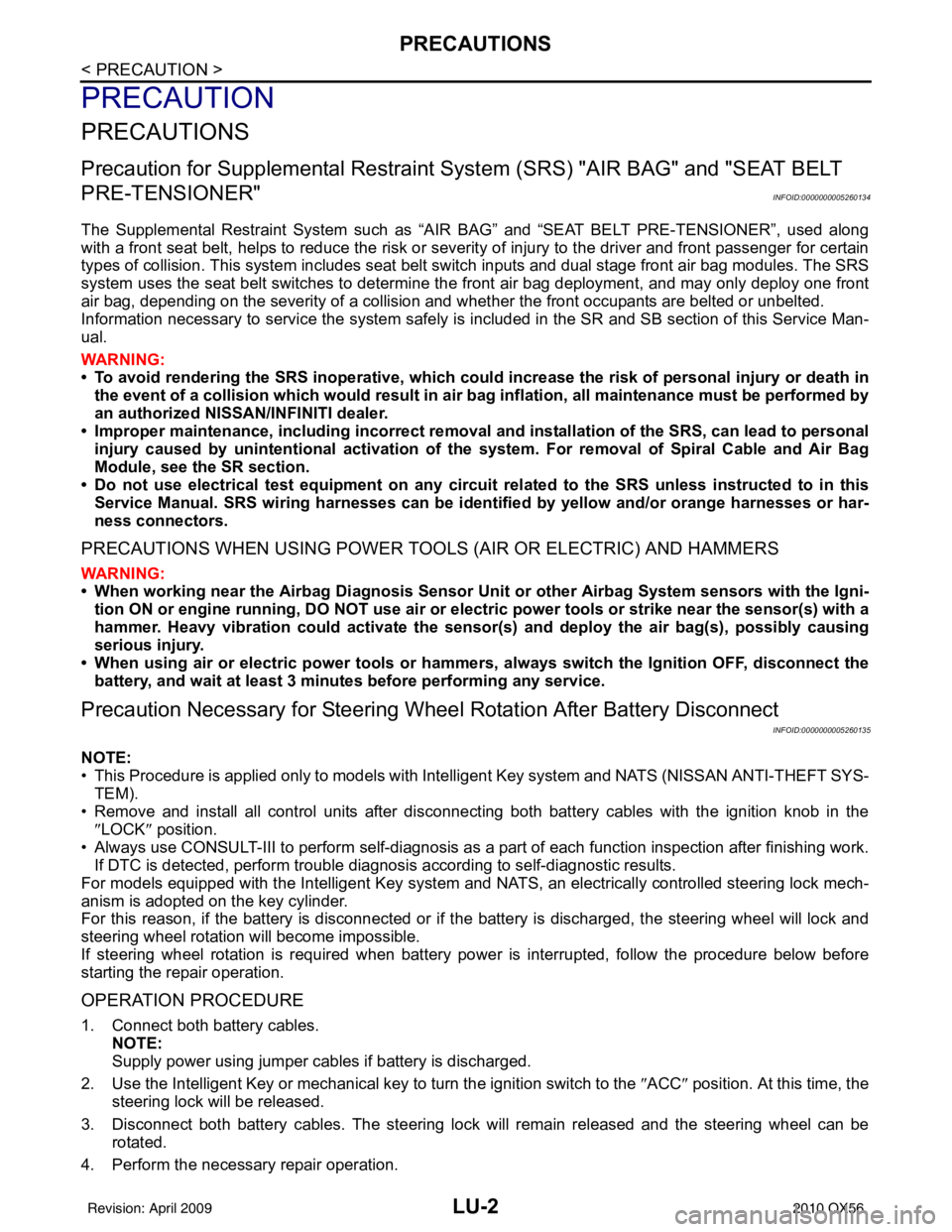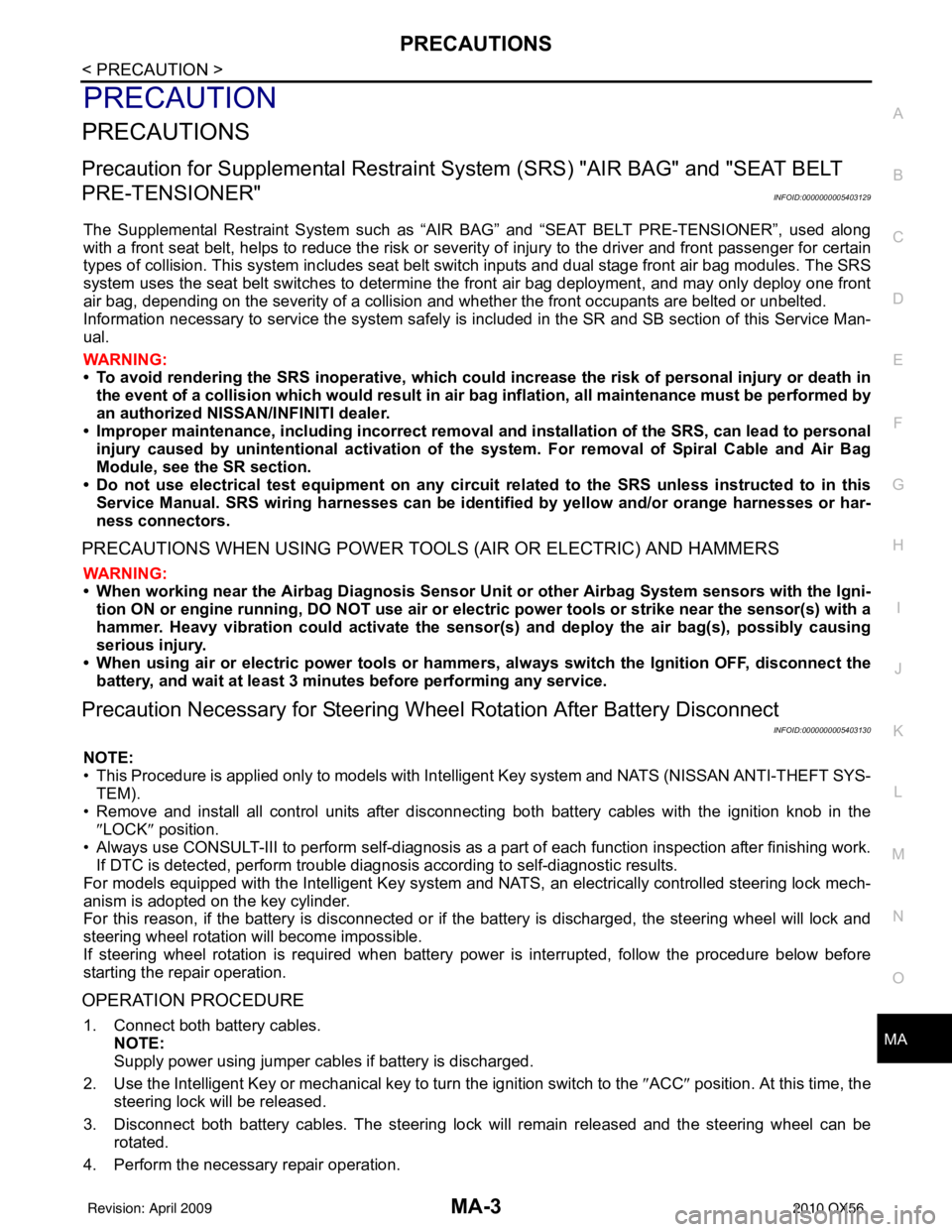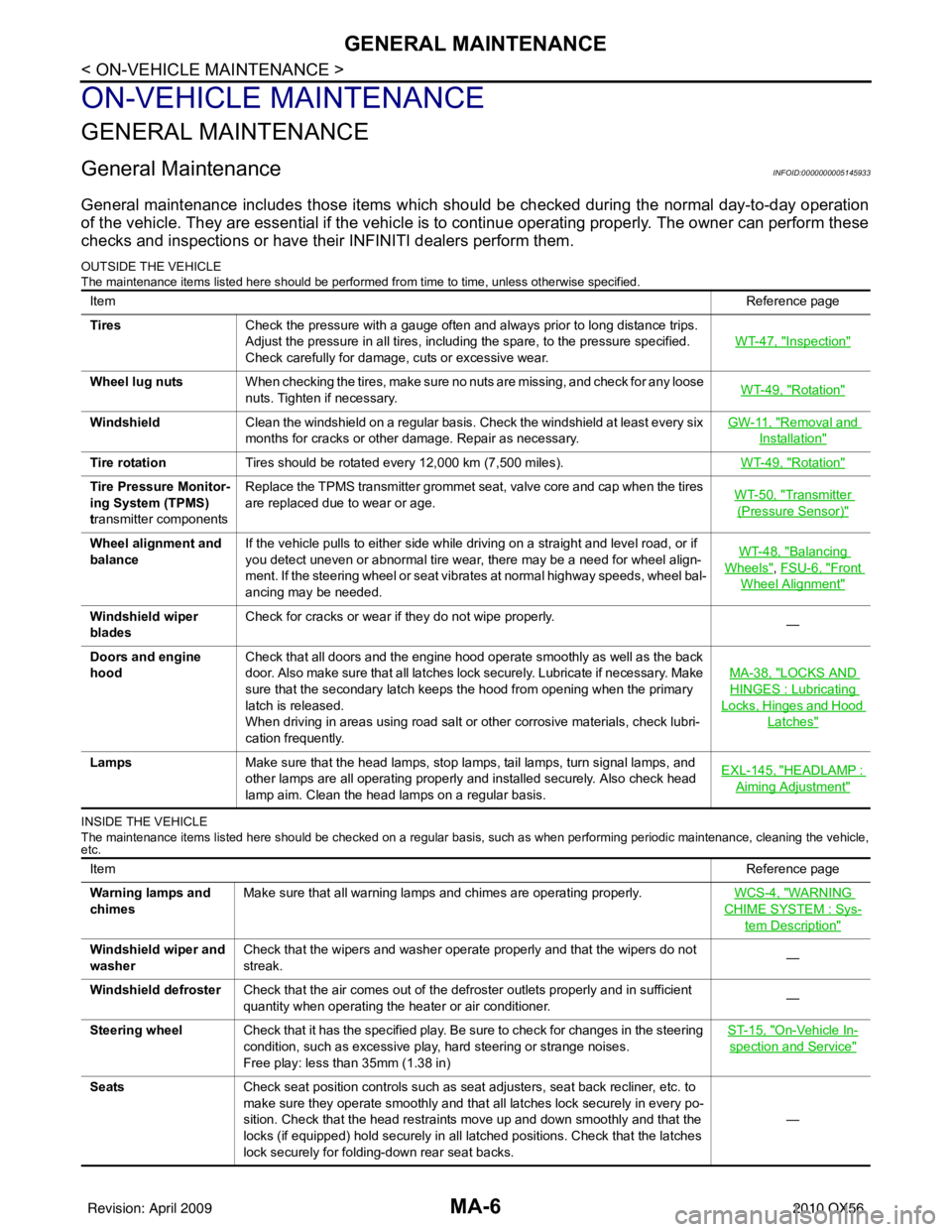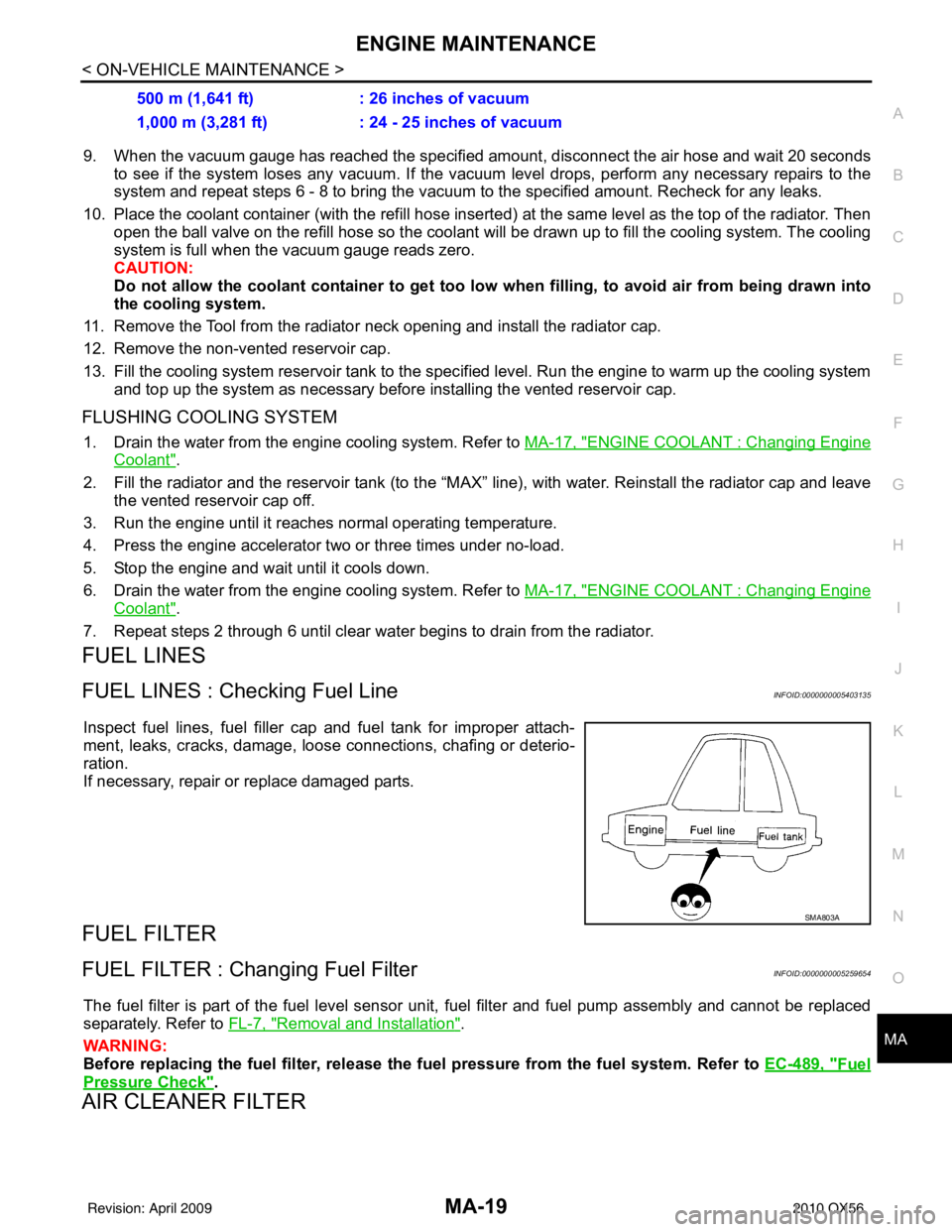2010 INFINITI QX56 sensor
[x] Cancel search: sensorPage 2662 of 4210
![INFINITI QX56 2010 Factory Service Manual LAN-64
< COMPONENT DIAGNOSIS >[CAN]
MAIN LINE BETWEEN LASER AND ICC CIRCUIT
MAIN LINE BETWEEN LA
SER AND ICC CIRCUIT
Diagnosis ProcedureINFOID:0000000005146473
1.CHECK CONNECTOR
1. Turn the ignition s INFINITI QX56 2010 Factory Service Manual LAN-64
< COMPONENT DIAGNOSIS >[CAN]
MAIN LINE BETWEEN LASER AND ICC CIRCUIT
MAIN LINE BETWEEN LA
SER AND ICC CIRCUIT
Diagnosis ProcedureINFOID:0000000005146473
1.CHECK CONNECTOR
1. Turn the ignition s](/manual-img/42/57032/w960_57032-2661.png)
LAN-64
< COMPONENT DIAGNOSIS >[CAN]
MAIN LINE BETWEEN LASER AND ICC CIRCUIT
MAIN LINE BETWEEN LA
SER AND ICC CIRCUIT
Diagnosis ProcedureINFOID:0000000005146473
1.CHECK CONNECTOR
1. Turn the ignition switch OFF.
2. Disconnect the battery cable from the negative terminal.
3. Check the following terminals and connectors for damage, bend and loose connection (connector side and harness side).
- Harness connector E34
- Harness connector B40
Is the inspection result normal?
YES >> GO TO 2.
NO >> Repair the terminal and connector.
2.CHECK HARNESS CONTI NUITY (OPEN CIRCUIT)
1. Disconnect the following harness connectors.
- ICC sensor
- Harness connectors E34 and B40
2. Check the continuity between the ICC sens or harness connector and the harness connector.
Is the inspection result normal?
YES >> GO TO 3.
NO >> Repair the main line between the ICC sensor and the harness connector E34.
3.CHECK HARNESS CONTI NUITY (OPEN CIRCUIT)
1. Disconnect the connector of ICC unit.
2. Check the continuity between the harness connector and the ICC unit harness connector.
Is the inspection result normal?
YES (Present error)>>Check the following items again. • Decision of CAN system type.
• Not received CONSULT-III data [SELF-DIAG RESULTS, CAN DIAG SUPPORT MNTR (“ECUlist” included)].
• Procedure for detecting root cause.
YES (Past error)>>Error was detected in the ma in line between the ICC sensor and the ICC unit.
NO >> Repair the main line between the harness connector B40 and the ICC unit.
ICC sensor harness connector Harness connector
Continuity
Connector No. Terminal No.Connector No. Terminal No.
E42 2
E34 24
Existed
3 23Existed
Harness connector ICC unit harness connector
Continuity
Connector No. Terminal No.Connector No. Terminal No.
B40 24
B13 14
Existed
23 5Existed
Revision: April 20092010 QX56
Page 2671 of 4210
![INFINITI QX56 2010 Factory Service Manual LAN
TCM BRANCH LINE CIRCUITLAN-73
< COMPONENT DIAGNOSIS > [CAN]
C
D
E
F
G H
I
J
K L
B A
O P
N
TCM BRANCH LINE CIRCUIT
Diagnosis ProcedureINFOID:0000000005152919
1.CHECK CONNECTOR
1. Turn the ignition INFINITI QX56 2010 Factory Service Manual LAN
TCM BRANCH LINE CIRCUITLAN-73
< COMPONENT DIAGNOSIS > [CAN]
C
D
E
F
G H
I
J
K L
B A
O P
N
TCM BRANCH LINE CIRCUIT
Diagnosis ProcedureINFOID:0000000005152919
1.CHECK CONNECTOR
1. Turn the ignition](/manual-img/42/57032/w960_57032-2670.png)
LAN
TCM BRANCH LINE CIRCUITLAN-73
< COMPONENT DIAGNOSIS > [CAN]
C
D
E
F
G H
I
J
K L
B A
O P
N
TCM BRANCH LINE CIRCUIT
Diagnosis ProcedureINFOID:0000000005152919
1.CHECK CONNECTOR
1. Turn the ignition switch OFF.
2. Disconnect the battery cabl e from the negative terminal.
3. Check the terminals and connectors of the A/T assembly for damage, bend and loose connection (unit
side and connector side).
Is the inspection result normal?
YES >> GO TO 2.
NO >> Repair the terminal and connector.
2.CHECK HARNESS FOR OPEN CIRCUIT
1. Disconnect the connector of A/T assembly.
2. Check the resistance between the A/T assembly harness connector terminals.
Is the measurement value within the specification?
YES >> GO TO 3.
NO >> Repair the TCM branch line.
3.CHECK HARNESS FOR OPEN CIRCUIT
1. Remove the control valve with TCM. Refer to TM-172, "
Control Valve with TCM and A/T Fluid Tempera-
ture Sensor 2 and Plug".
2. Disconnect the connector of TCM.
3. Check the continuity between the A/T a ssembly connector and the TCM harness connector.
Is the inspection result normal?
YES >> GO TO 4.
NO >> Repair the harness between the A/T asse mbly connector and the TCM harness connector.
4.CHECK POWER SUPPLY AND GROUND CIRCUIT
Check the power supply and the ground circuit of the TCM. Refer to TM-94, "
Diagnosis Procedure".
Is the inspection result normal?
YES (Present error)>>Replace the control valve with TCM. Refer to TM-172, "Control Valve with TCM and A/
T Fluid Temperature Sensor 2 and Plug".
YES (Past error)>>Error was detected in the TCM branch line.
NO >> Repair the power supply and the ground circuit.
A/T assembly harness connector Resistance (Ω)
Connector No. Terminal No.
F9 3 8 Approx. 54 – 66
A/T assembly connector TCM harness connector
Continuity
Terminal No. Connector No. Terminal No.
3 F502 1
Existed
82 Exis te d
Revision: April 20092010 QX56
Page 2672 of 4210
![INFINITI QX56 2010 Factory Service Manual LAN-74
< COMPONENT DIAGNOSIS >[CAN]
LASER BRANCH LINE CIRCUIT
LASER BRANCH LINE CIRCUIT
Diagnosis ProcedureINFOID:0000000005146481
1.CHECK CONNECTOR
1. Turn the ignition switch OFF.
2. Disconnect the INFINITI QX56 2010 Factory Service Manual LAN-74
< COMPONENT DIAGNOSIS >[CAN]
LASER BRANCH LINE CIRCUIT
LASER BRANCH LINE CIRCUIT
Diagnosis ProcedureINFOID:0000000005146481
1.CHECK CONNECTOR
1. Turn the ignition switch OFF.
2. Disconnect the](/manual-img/42/57032/w960_57032-2671.png)
LAN-74
< COMPONENT DIAGNOSIS >[CAN]
LASER BRANCH LINE CIRCUIT
LASER BRANCH LINE CIRCUIT
Diagnosis ProcedureINFOID:0000000005146481
1.CHECK CONNECTOR
1. Turn the ignition switch OFF.
2. Disconnect the battery cable from the negative terminal.
3. Check the terminals and connectors of the ICC s ensor for damage, bend and loose connection (unit side
and connector side).
Is the inspection result normal?
YES >> GO TO 2.
NO >> Repair the terminal and connector.
2.CHECK HARNESS FOR OPEN CIRCUIT
1. Disconnect the connector of ICC sensor.
2. Check the resistance between the ICC sensor harness connector terminals.
Is the measurement value within the specification?
YES >> GO TO 3.
NO >> Repair the ICC sensor branch line.
3.CHECK POWER SUPPLY AND GROUND CIRCUIT
Check the power supply and the ground circuit of the ICC sensor. Refer to CCS-48, "
Wiring Diagram".
Is the inspection result normal?
YES (Present error)>>Replace the ICC sensor. Refer to CCS-72, "ICC Sensor".
YES (Past error)>>Error was detect ed in the ICC sensor branch line.
NO >> Repair the power supply and the ground circuit.
ICC sensor harness connector Resistance (Ω)
Connector No. Terminal No.
E42 23Approx. 54 – 66
Revision: April 20092010 QX56
Page 2681 of 4210
![INFINITI QX56 2010 Factory Service Manual LAN
STRG BRANCH LINE CIRCUITLAN-83
< COMPONENT DIAGNOSIS > [CAN]
C
D
E
F
G H
I
J
K L
B A
O P
N
STRG BRANCH
LINE CIRCUIT
Diagnosis ProcedureINFOID:0000000005146490
1.CHECK CONNECTOR
1. Turn the igniti INFINITI QX56 2010 Factory Service Manual LAN
STRG BRANCH LINE CIRCUITLAN-83
< COMPONENT DIAGNOSIS > [CAN]
C
D
E
F
G H
I
J
K L
B A
O P
N
STRG BRANCH
LINE CIRCUIT
Diagnosis ProcedureINFOID:0000000005146490
1.CHECK CONNECTOR
1. Turn the igniti](/manual-img/42/57032/w960_57032-2680.png)
LAN
STRG BRANCH LINE CIRCUITLAN-83
< COMPONENT DIAGNOSIS > [CAN]
C
D
E
F
G H
I
J
K L
B A
O P
N
STRG BRANCH
LINE CIRCUIT
Diagnosis ProcedureINFOID:0000000005146490
1.CHECK CONNECTOR
1. Turn the ignition switch OFF.
2. Disconnect the battery cabl e from the negative terminal.
3. Check the terminals and connectors of the steer ing angle sensor for damage, bend and loose connection
(unit side and connector side).
Is the inspection result normal?
YES >> GO TO 2.
NO >> Repair the terminal and connector.
2.CHECK HARNESS FOR OPEN CIRCUIT
1. Disconnect the connector of steering angle sensor.
2. Check the resistance between the steering angle sensor harness connector terminals.
Is the measurement value within the specification?
YES >> GO TO 3.
NO >> Repair the steering angle sensor branch line.
3.CHECK POWER SUPPLY AND GROUND CIRCUIT
Check the power supply and the ground circuit of the steering angle sensor. Refer to BRC-92, "
Wiring Dia-
gram - BRAKE CONTROL SYSTEM -".
Is the inspection result normal?
YES (Present error)>>Replace the steering angle sensor. Refer to BRC-118, "Removal and Installation".
YES (Past error)>>Error was detected in the steering angle sensor branch line.
NO >> Repair the power supply and the ground circuit.
Steering angle sensor harness connector Resistance (Ω)
Connector No. Terminal No.
M17 4 5 Approx. 54 – 66
Revision: April 20092010 QX56
Page 2688 of 4210

LU-2
< PRECAUTION >
PRECAUTIONS
PRECAUTION
PRECAUTIONS
Precaution for Supplemental Restraint System (SRS) "AIR BAG" and "SEAT BELT
PRE-TENSIONER"
INFOID:0000000005260134
The Supplemental Restraint System such as “A IR BAG” and “SEAT BELT PRE-TENSIONER”, used along
with a front seat belt, helps to reduce the risk or severity of injury to the driver and front passenger for certain
types of collision. This system includes seat belt switch inputs and dual stage front air bag modules. The SRS
system uses the seat belt switches to determine the front air bag deployment, and may only deploy one front
air bag, depending on the severity of a collision and w hether the front occupants are belted or unbelted.
Information necessary to service the system safely is included in the SR and SB section of this Service Man-
ual.
WARNING:
• To avoid rendering the SRS inopera tive, which could increase the risk of personal injury or death in
the event of a collision which would result in air bag inflation, all maintenance must be performed by
an authorized NISSAN/INFINITI dealer.
• Improper maintenance, including in correct removal and installation of the SRS, can lead to personal
injury caused by unintent ional activation of the system. For re moval of Spiral Cable and Air Bag
Module, see the SR section.
• Do not use electrical test equipmen t on any circuit related to the SRS unless instructed to in this
Service Manual. SRS wiring harn esses can be identified by yellow and/or orange harnesses or har-
ness connectors.
PRECAUTIONS WHEN USING POWER TOOLS (AIR OR ELECTRIC) AND HAMMERS
WARNING:
• When working near the Airbag Diagnosis Sensor Unit or other Airbag System sensors with the Igni-
tion ON or engine running, DO NOT use air or electri c power tools or strike near the sensor(s) with a
hammer. Heavy vibration could activate the sensor( s) and deploy the air bag(s), possibly causing
serious injury.
• When using air or electric power tools or hammers , always switch the Ignition OFF, disconnect the
battery, and wait at least 3 minu tes before performing any service.
Precaution Necessary for Steering W heel Rotation After Battery Disconnect
INFOID:0000000005260135
NOTE:
• This Procedure is applied only to models with Intelligent Key system and NATS (NISSAN ANTI-THEFT SYS-
TEM).
• Remove and install all control units after disconnecting both battery cables with the ignition knob in the
″LOCK ″ position.
• Always use CONSULT-III to perform self-diagnosis as a part of each function inspection after finishing work.
If DTC is detected, perform trouble diagnosis according to self-diagnostic results.
For models equipped with the Intelligent Key system and NATS, an electrically controlled steering lock mech-
anism is adopted on the key cylinder.
For this reason, if the battery is disconnected or if the battery is discharged, the steering wheel will lock and
steering wheel rotation will become impossible.
If steering wheel rotation is required when battery pow er is interrupted, follow the procedure below before
starting the repair operation.
OPERATION PROCEDURE
1. Connect both battery cables. NOTE:
Supply power using jumper cables if battery is discharged.
2. Use the Intelligent Key or mechanical key to turn the ignition switch to the ″ACC ″ position. At this time, the
steering lock will be released.
3. Disconnect both battery cables. The steering lock will remain released and the steering wheel can be rotated.
4. Perform the necessary repair operation.
Revision: April 20092010 QX56
Page 2707 of 4210

PRECAUTIONSMA-3
< PRECAUTION >
C
DE
F
G H
I
J
K L
M B
MA
N
O A
PRECAUTION
PRECAUTIONS
Precaution for Supplemental
Restraint System (SRS) "AIR BAG" and "SEAT BELT
PRE-TENSIONER"
INFOID:0000000005403129
The Supplemental Restraint System such as “AIR BAG” and “SEAT BELT PRE-TENSIONER”, used along
with a front seat belt, helps to reduce the risk or severi ty of injury to the driver and front passenger for certain
types of collision. This system includes seat belt switch inputs and dual stage front air bag modules. The SRS
system uses the seat belt switches to determine the front air bag deployment, and may only deploy one front
air bag, depending on the severity of a collision and w hether the front occupants are belted or unbelted.
Information necessary to service the system safely is included in the SR and SB section of this Service Man-
ual.
WARNING:
• To avoid rendering the SRS inoper ative, which could increase the risk of personal injury or death in
the event of a collision which would result in air bag inflation, all maintenance must be performed by
an authorized NISSAN/INFINITI dealer.
• Improper maintenance, including in correct removal and installation of the SRS, can lead to personal
injury caused by unintentional act ivation of the system. For removal of Spiral Cable and Air Bag
Module, see the SR section.
• Do not use electrical test equipm ent on any circuit related to the SRS unless instructed to in this
Service Manual. SRS wiring harnesses can be identi fied by yellow and/or orange harnesses or har-
ness connectors.
PRECAUTIONS WHEN USING POWER TOOLS (AIR OR ELECTRIC) AND HAMMERS
WARNING:
• When working near the Airbag Diagnosis Sensor Un it or other Airbag System sensors with the Igni-
tion ON or engine running, DO NOT use air or el ectric power tools or strike near the sensor(s) with a
hammer. Heavy vibration could activate the sensor( s) and deploy the air bag(s), possibly causing
serious injury.
• When using air or electric power tools or hammers, always switch the Ignition OFF, disconnect the battery, and wait at least 3 minutes before performing any service.
Precaution Necessary for Steering Wheel Rotation After Battery Disconnect
INFOID:0000000005403130
NOTE:
• This Procedure is applied only to models with Intelligent Key system and NATS (NISSAN ANTI-THEFT SYS-
TEM).
• Remove and install all control units after disconnecti ng both battery cables with the ignition knob in the
″ LOCK ″ position.
• Always use CONSULT-III to perform self-diagnosis as a part of each function inspection after finishing work.
If DTC is detected, perform trouble diagnosis according to self-diagnostic results.
For models equipped with the Intelligent Key system and NATS , an electrically controlled steering lock mech-
anism is adopted on the key cylinder.
For this reason, if the battery is disconnected or if the battery is discharged, the steering wheel will lock and
steering wheel rotation will become impossible.
If steering wheel rotation is required when battery power is interrupted, follow the procedure below before
starting the repair operation.
OPERATION PROCEDURE
1. Connect both battery cables. NOTE:
Supply power using jumper cables if battery is discharged.
2. Use the Intelligent Key or mechanical key to turn the ignition switch to the ″ACC ″ position. At this time, the
steering lock will be released.
3. Disconnect both battery cables. The steering lock will remain released and the steering wheel can be
rotated.
4. Perform the necessary repair operation.
Revision: April 20092010 QX56
Page 2710 of 4210

MA-6
< ON-VEHICLE MAINTENANCE >
GENERAL MAINTENANCE
ON-VEHICLE MAINTENANCE
GENERAL MAINTENANCE
General MaintenanceINFOID:0000000005145933
General maintenance includes those items which should be checked during the normal day-to-day operation
of the vehicle. They are essential if the vehicle is to continue operating properly. The owner can perform these
checks and inspections or have thei r INFINITI dealers perform them.
OUTSIDE THE VEHICLE
The maintenance items listed here should be performed fr om time to time, unless otherwise specified.
INSIDE THE VEHICLE
The maintenance items listed here should be checked on a regular basis, such as when performing periodic maintenance, cleaning the vehicle,
etc.
Item Reference page
Tires Check the pressure with a gauge often and always prior to long distance trips.
Adjust the pressure in all tires, including the spare, to the pressure specified.
Check carefully for damage, cuts or excessive wear. WT-47, "
Inspection"
Wheel lug nuts
When checking the tires, make sure no nuts are missing, and check for any loose
nuts. Tighten if necessary. WT-49, "Rotation"
Windshield
Clean the windshield on a regular basis. Check the windshield at least every six
months for cracks or other damage. Repair as necessary. GW-11, "Removal and
Installation"
Tire rotation
Tires should be rotated every 12,000 km (7,500 miles). WT-49, "Rotation"
Tire Pressure Monitor-
ing System (TPMS)
transmitter componentsReplace the TPMS transmitter grommet seat, valve core and cap when the tires
are replaced due to wear or age.
WT-50, "Transmitter
(Pressure Sensor)"
Wheel alignment and
balanceIf the vehicle pulls to either side while driving on a straight and level road, or if
you detect uneven or abnormal tire wear, there may be a need for wheel align-
ment. If the steering wheel or seat vibrates at normal highway speeds, wheel bal-
ancing may be needed. WT-48, "Balancing
Wheels", FSU-6, "Front
Wheel Alignment"
Windshield wiper
blades
Check for cracks or wear if they do not wipe properly.
—
Doors and engine
hood Check that all doors and the engine hood operate smoothly as well as the back
door. Also make sure that all latches lock securely. Lubricate if necessary. Make
sure that the secondary latch keeps the hood from opening when the primary
latch is released.
When driving in areas using road salt or other corrosive materials, check lubri-
cation frequently. MA-38, "
LOCKS AND
HINGES : Lubricating
Locks, Hinges and Hood
Latches"
Lamps
Make sure that the head lamps, stop lamps, tail lamps, turn signal lamps, and
other lamps are all operating properly and installed securely. Also check head
lamp aim. Clean the head lamps on a regular basis. EXL-145, "HEADLAMP :
Aiming Adjustment"
Item
Reference page
Warning lamps and
chimes Make sure that all warning lamps and chimes are operating properly.
WCS-4, "
WARNING
CHIME SYSTEM : Sys-
tem Description"
Windshield wiper and
washerCheck that the wipers and washer operate properly and that the wipers do not
streak.
—
Windshield defroster Check that the air comes out of the defroster outlets properly and in sufficient
quantity when operating the heater or air conditioner. —
Steering wheel Check that it has the specified play. Be sure to check for changes in the steering
condition, such as excessive play, hard steering or strange noises.
Free play: less than 35mm (1.38 in) ST-15, "
On-Vehicle In-
spection and Service"
Seats
Check seat position controls such as seat adjusters, seat back recliner, etc. to
make sure they operate smoothly and that all latches lock securely in every po-
sition. Check that the head restraints move up and down smoothly and that the
locks (if equipped) hold securely in all latched positions. Check that the latches
lock securely for folding-down rear seat backs. —
Revision: April 20092010 QX56
Page 2723 of 4210

ENGINE MAINTENANCEMA-19
< ON-VEHICLE MAINTENANCE >
C
DE
F
G H
I
J
K L
M B
MA
N
O A
9. When the vacuum gauge has reached the specified
amount, disconnect the air hose and wait 20 seconds
to see if the system loses any vacuum. If the vacuum level drops, perform any necessary repairs to the
system and repeat steps 6 - 8 to br ing the vacuum to the specified amount. Recheck for any leaks.
10. Place the coolant container (with the refill hose inserted) at the same level as the top of the radiator. Then
open the ball valve on the refill hose so the coolant will be drawn up to fill the cooling system. The cooling
system is full when the vacuum gauge reads zero.
CAUTION:
Do not allow the coolant container to get too low when filling, to avoid air from being drawn into
the cooling system.
11. Remove the Tool from the radiator neck opening and install the radiator cap.
12. Remove the non-vented reservoir cap.
13. Fill the cooling system reservoir tank to the specified level. Run the engine to warm up the cooling system and top up the system as necessary befor e installing the vented reservoir cap.
FLUSHING COOLING SYSTEM
1. Drain the water from the engine cooling system. Refer to MA-17, "ENGINE COOLANT : Changing Engine
Coolant".
2. Fill the radiator and the reservoir tank (to the “MAX” line), with water. Reinstall the radiator cap and leave
the vented reservoir cap off.
3. Run the engine until it reaches normal operating temperature.
4. Press the engine accelerator two or three times under no-load.
5. Stop the engine and wait until it cools down.
6. Drain the water from the engine cooling system. Refer to MA-17, "
ENGINE COOLANT : Changing Engine
Coolant".
7. Repeat steps 2 through 6 until clear water begins to drain from the radiator.
FUEL LINES
FUEL LINES : Checking Fuel LineINFOID:0000000005403135
Inspect fuel lines, fuel filler cap and fuel tank for improper attach-
ment, leaks, cracks, damage, loos e connections, chafing or deterio-
ration.
If necessary, repair or replace damaged parts.
FUEL FILTER
FUEL FILTER : Changing Fuel FilterINFOID:0000000005259654
The fuel filter is part of the fuel level sensor unit, fuel filter and fuel pump assembly and cannot be replaced
separately. Refer to FL-7, "
Removal and Installation".
WARNING:
Before replacing the fuel filter, release the fuel pressure from the fuel system. Refer to EC-489, "
Fuel
Pressure Check".
AIR CLEANER FILTER
500 m (1,641 ft): 26 inches of vacuum
1,000 m (3,281 ft) : 24 - 25 inches of vacuum
SMA803A
Revision: April 20092010 QX56